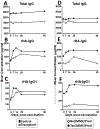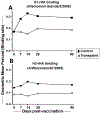Kinetics of antibody response to influenza vaccination in renal transplant recipients
- PMID: 30664927
- PMCID: PMC6471676
- DOI: 10.1016/j.trim.2019.01.001
Kinetics of antibody response to influenza vaccination in renal transplant recipients
Abstract
Annual vaccination is routinely used in organ transplant recipients for immunization against seasonal influenza. However, detailed analysis of the kinetics of vaccine-induced immune responses in this population is lacking. In this study, we investigated the kinetics of vaccine strains-specific antibody responses to trivalent influenza vaccine in a group of renal transplant recipients and a control group. First, we found that the geometric mean hemagglutination inhibition titer against all 3 vaccine strains in the transplant cohort was significantly low when compared to control subjects. Next, whereas the control group sera showed significantly higher HA-specific IgG and isotype IgG1 antibodies at all four time points, a similar increase in the transplant group was delayed until day 28. Interestingly, within the transplant group, subjects receiving belatacept/MMF/prednisone-based regimen had significantly lower levels of total IgG and HA-specific IgG when compared to tacrolimus/MMF/prednisone-based regimen. Even though IgG-ASC response in both cohorts peaked at day 7 post-vaccination, the frequency of IgG-ASC was significantly low in the transplant group. Taken together, our studies show delayed kinetics and lower levels of influenza vaccine-specific antibody responses in renal transplant recipients and, more importantly, indicate the need to probe and improve current vaccination strategies in renal transplant recipients.
Keywords: Antibody; Immunosuppression; Influenza; Kidney transplant; Vaccination.
Published by Elsevier B.V.
Figures




References
-
- Delaney JW and Fowler RA. 2009 influenza A (H1N1): a clinical review. Hosp Pract (1995) 2010; 38(2): 74–81. - PubMed
-
- Monto AS and Whitley RJ. Seasonal and pandemic influenza: a 2007 update on challenges and solutions. Clin Infect Dis 2008; 46(7): 1024–1031. - PubMed
-
- Hoelscher M, Gangappa S, Zhong W, Jayashankar L, and Sambhara S. Vaccines against epidemic and pandemic influenza. Expert Opin Drug Deliv 2008; 5(10): 1139–1157. - PubMed
-
- Gangappa S, Kokko KE, Carlson LM et al. Immune responsiveness and protective immunity after transplantation. Transpl Int 2008; 21(4): 293–303. - PubMed
-
- Novel Swine-Origin Influenza AVIT, Dawood FS, Jain S et al. Emergence of a novel swine-origin influenza A (H1N1) virus in humans. N Engl J Med 2009; 360(25): 2605–2615. - PubMed
Publication types
MeSH terms
Substances
Grants and funding
LinkOut - more resources
Full Text Sources
Medical
Miscellaneous

